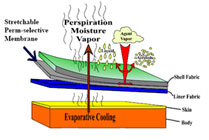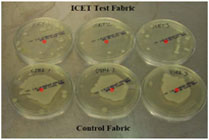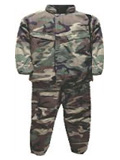Active and Passive Microbial and Chemical Protective Materials
- A passive barrier blocks chemical agents, biological agents, aerosols.
- An active barrier provides a reactive environment for bio agent inactivation.
- Potential solution for active chemical agent protection.
- Unique catalysts/biocide incorporated materials. Coatings for textiles.
- Coatings for non-wovens.
- Currently undergoing evaluation for garments.
- Industrial and Manufacturing Partners for scale up and supply .
- Applications include military and homeland security.
Moisture Vapor Breathability with Protective Features
- Self -decontaminating.
- Water vapor permeable; not liquid water permeable.
- CBW agent impermeable.
- Reduced weight; ~12-16 mil total thickness.
- Low Thermal burden.
Active Surface Protective Materials
 Active AND Passive barrier e Protective Materials
Active AND Passive barrier e Protective Materials
The objective of this study was to evaluate the effectiveness of the active surface fabric to inactivate Bacillus anthracis Ames spores. Efficacy of the fabric was determined by calculating the percent recovery and log reduction in viable B. anthracis Ames spores recovered from the test fabric when compared to the control. Currently only Passive Barrier material that are impermeable to chemicals and microorganisms are sold commercially. These materials discomfort the wearer due to heat stress and requires personal cooling systems. Further these suits need a biocide wash.
Anthrax Spore testing (3rd party evaluation by an Army Certified Laboratory)
 Represents contact transfer results, asterisks (*) represent contact site.
Represents contact transfer results, asterisks (*) represent contact site.
The objective of this study was to evaluate the effectiveness of the active surface fabric to inactivate Bacillus anthracis Ames spores. Efficacy of the fabric was determined by calculating the percent recovery and log reduction in viable B. anthracis Ames spores recovered from the test fabric when compared to the control. Currently only Passive Barrier material that are impermeable to chemicals and microorganisms are sold commercially. These materials discomfort the wearer due to heat stress and requires personal cooling systems. Further these suits need a biocide wash.
The ICET advantage is a material that is
- Self-decontaminating
- Moisture breathable formulation
- Functionality
- Coatings for textiles
- Coatings for non-wovens
 A material with breathable properties offers clear advantages. When the body builds up too much internal heat it responds by perspiration. In a non-breathable suit, the perspiration is unable to evaporate and provide cooling. The strain on the body can produce a condition known as heat stress. Heat stress can range from minor discomfort to serious health problems. Fainting and heat exhaustion are familiar results of short-term exposure. Prolonged heat stress can cause serious injury and may even be fatal for some workers. A key criteria in selecting comfortable protective apparel with low heat-stress potential is how easily heat and humidity escape from inside the garment. Diffusion measurements such as the moisture vapor transmission rate (MVTR) are industry standards. Movement produces air currents that speed up the rate at which moisture moves through the fabric. Protective fabrics that breathe are significantly more comfortable under hot, humid conditions.
A material with breathable properties offers clear advantages. When the body builds up too much internal heat it responds by perspiration. In a non-breathable suit, the perspiration is unable to evaporate and provide cooling. The strain on the body can produce a condition known as heat stress. Heat stress can range from minor discomfort to serious health problems. Fainting and heat exhaustion are familiar results of short-term exposure. Prolonged heat stress can cause serious injury and may even be fatal for some workers. A key criteria in selecting comfortable protective apparel with low heat-stress potential is how easily heat and humidity escape from inside the garment. Diffusion measurements such as the moisture vapor transmission rate (MVTR) are industry standards. Movement produces air currents that speed up the rate at which moisture moves through the fabric. Protective fabrics that breathe are significantly more comfortable under hot, humid conditions.



